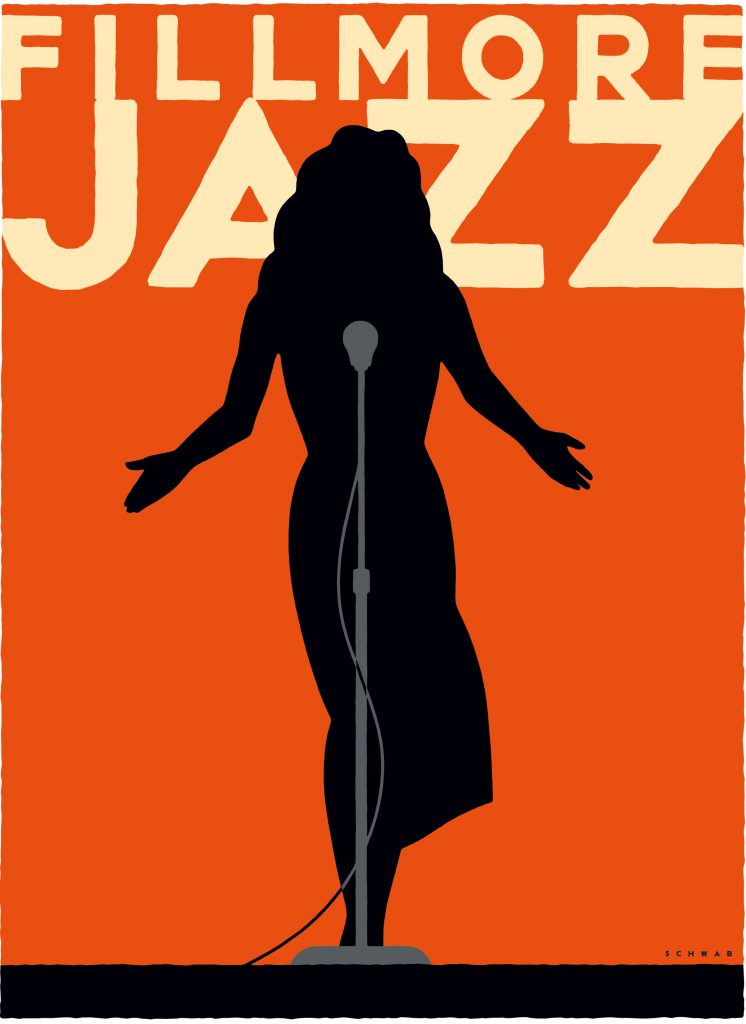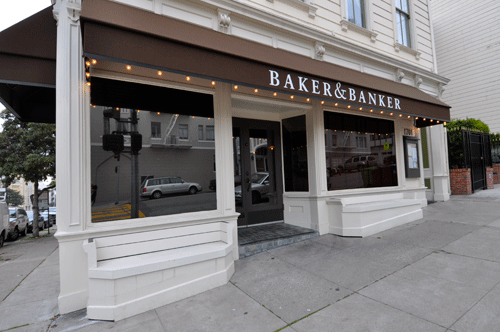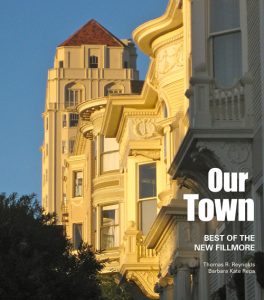By Chris Barnett
It’s a simple Victorian storefront at Octavia and Bush, but the building housing Baker & Banker has a notorious past.
Vintage San Franciscans will remember the spot as Robert Restaurant Francais during the 70s and 80s — a small and stylish place with a popular appetizer not listed on the menu. One day the cops busted through the front door — without reservations — just as one of Robert’s kingpins disappeared out the back door, much to the disappointment of patrons who favored his cocaine-to-go-go.
The architecturally unremarkable Victorian was built in 1882 as an apothecary shop where medicines were hand-ground by mortar and pestle; Octavia Street Apothecary and Laundry was a longtime tenant. Three apartments were built over the store — the landlord still lives in one of them.
More fascinating — although tough to prove — is that the building was once used as a storeroom by Mary Ellen Pleasant, who owned what was said to be a boarding house across Bush Street that also did a brisk business as a brothel. Pleasant, who billed herself as a “slave born to a Voodoo priestess,” made madam-turned-mayor of Sausalito Sally Stanford a choirgirl by comparison.
A committed abolitionist and slick self-promoter, Pleasant grabbed headlines as San Francisco’s first “black entrepreneur,” and was also pilloried in the press as “Mammy Pleasant” — an appellation she abhorred, but it stuck. She became a financial angel to John Brown on the Underground Railroad and pluckily desegregated the city’s horse-drawn streetcars.
Pleasant was said to lure young hookers off the Barbary Coast and set them up as hostesses in elegant gentlemen’s dining clubs she established in boarding houses she owned. She wooed young Scottish banker Thomas Bell and amassed a $30 million fortune in the late 1880s from financial tips gleaned by her ladies from the wealthy gents they served and serviced. It’s coincidental — or prophetic — that a banker and his partner were plying the prominent with lavish meals in virtually the same spot more than a century ago.
By the 1930s, lore — and not much more — has it that 1701 Octavia had
morphed into a series of drugstores and then an open-front corner grocery. According to one tale, the grocer didn’t trust banks or the IRS and buried his receipts. But apparently his memory wasn’t so hot; another historical nugget tells of remodelers tearing up the floor and unearthing $5,000 in cash.
There are some gaping holes in the building’s heritage, but it migrated into its culinary era in the 1970s. Judith Ets-Hokin turned it into one of her popular HomeChef cooking schools, which grew to a chain of eight bought by Viking, the pricey oven and fridge maker. The storefront debuted as a restaurant when it opened as Robert’s, which had an 18-year run before suddenly shutting its doors.
Robert’s became Michael’s around 1987, but died after less than a year —
deservedly so, in my opinion. In another life, I dined there with my bride just a few hours after our “I do’s.” She looked stunning in her white wedding dress; I was trussed up in my tux. But we couldn’t get a waiter, let alone a glass of champagne, for at least 10 long minutes — and the place was virtually empty. Finally, after some less than subtle waving and maybe a snide “Excuse me, but is this a cafeteria?” a server moseyed over, less than enthused. By then, so were we.
When Michael’s died, La Fiametta moved in and served Italian food for nearly a decade, checking out just before dot-com mania hit the city and the stock market started skyrocketing.
It was in 1996 that 1701 Octavia became the Meeting House — a hotspot for foodies — when chef Joanna Karlinsky and her business partner John Bryant Snell took it over.
“It was a time when restaurant designers were running wild — remember Cypress Club? — with wild colors, diamond-studded ceilings, leather banquettes,” Karlinsky recalls. “We saw it as a place for simple, seasonal, classic American cuisine, a Quaker meeting house, with Shaker decor.”
White linen, hardwood floors, candles, plants, a visual return to the building’s 1880s roots — and rave reviews — powered the place through the triple whammy of the dot-com collapse, the 2001 market crash and the recession before this one. Karlinsky turned off the stoves in 2004 after an almost nine-year high-profile run, then partnered with Peter Snyderman and Stephen Katten to take the reins of the venerable Elite Cafe on Fillmore. Now she runs an inventive, casual eatery called Sweet Jo’s in the Jewish Community Center on California Street.
Michael Tusk upped the room’s reputation as a hideaway for excellent food when he opened Quince in 2005 and dazzled the critics and foodies. But before long, he wanted a bigger, fancier location for his Michelin star. Quince moved downtown last year to 470 Pacific, where Myth lived large until its quixotic owner and serial restaurateur Tom Duffy died.
And now Quince has handed the baton to the well-seasoned husband and wife team of Lori Baker and Jeff Banker, who’ve clearly opted for style and sophistication. But they’ve also promised to make it a warm place that will welcome the locals — and, with a little luck, stir up a few stories of its own.
Filed under: Food, Drink & Lodging





